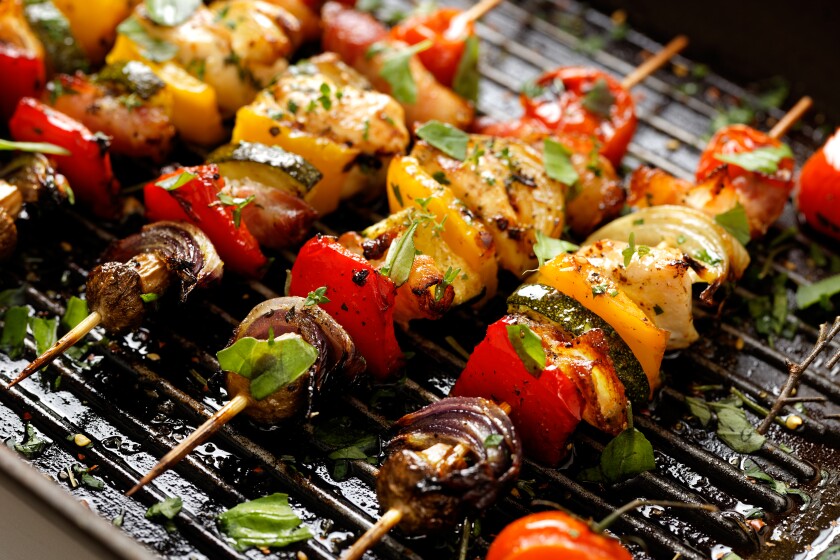Summer officially starts next week, and many of us are already enjoying summer cooking, including barbecues and picnics. Many common barbecue foods come to mind when thinking of summer foods, including hamburgers, brats, hot dogs, potato salads, baked beans and chips and dip. The options are endless. Before you fire up the grill, think about the nutrient content of your foods to make better choices for your health. A few changes to how you grill could help you reach your nutrition goals.
The first item we plan is usually the meat or the entrée item. Many times, the protein food we select is highly processed, such as brats and hot dogs, or highly sauced like barbecue ribs.
Processed meat means the meat has been smoked, cured, fermented or salted, often to enhance the flavor of the food. They tend to be high in sodium and can be high in saturated fat, which can lead to high blood pressure and cholesterol, heart disease and stroke.
READ MORE ABOUT GRILLING:
ADVERTISEMENT
Select leaner protein options more often, such as grilled fish and poultry. If two protein options are being served and you cannot decide between the two, share both options with someone. Portion control of protein foods can make a big difference in the amount of sodium, saturated fat and total calories you eat. A smaller portion allows you to fill up on more nutrient-dense foods like fruits, vegetables and whole grains.
Keep whole-grain options available to improve the fiber content of the meal. Fiber has many health benefits, including promoting heart and digestive health and helping to keep us feeling full. For foods that use a bun, such as hot dogs and hamburger, look for a whole-grain bun. Pasta salads can be made with whole-grain pasta; even a mix of half whole grain and half white pasta can make a difference. Rather than the traditional picnic salads, try a new salad featuring a whole grain such as a quinoa, barley or farro.
Many side dishes are high in sodium, saturated fat and sugar — and they're often served in large portion sizes. Potato salads, pasta salad and baked beans are a few that come to mind. Enjoy these higher sodium, saturated fat and added sugar foods by taking a small portion and filling half your plate with fruits and vegetables. Try grilling vegetables in the form of kabobs or make vegetables the side dish such as corn on the cob, asparagus or green beans.
Fruit can also be grilled, such as grilled watermelon or pineapple, and make for a great dessert. A fruit salad offering can be a great way to add fruit to the meal if you don’t want to have it grilled. A good rule of thumb should be to make half your plate fruits and/or vegetables. To ensure healthy options at a gathering, volunteer to bring a vegetable tray or fruit salad.
Beverages are a must for a hot summer barbecue to help keep us hydrated. We often forget about the calories and sugar that come from beverages, causing extra calories from sugary drinks to add up fast. The majority of the beverages we drink should be calorie-free or low in calories, such as plain or flavored water and unsweetened tea.
If plain water is not enough, try flavoring it with mint, cucumbers or lemon. If you want a sugary drink like regular pop, lemonade or sweet tea, limit your portion to one can or a small glass, then switch to water. If you drink alcohol, do so in moderation. The recommendation is to limit alcohol to one drink per day for women and two drinks per day for men. Remember to drink more water and low-calorie beverages on hot days and when you are active.
Stay active during the barbecue. Get up and move while the food is cooking or after you clean up the meal. Take a walk around the park or bring a ball to play with. If you are having a barbecue at home, walk around the neighborhood after the meal or play your favorite yard game. Adding an activity is a great way to complement a healthy meal.
ADVERTISEMENT
Barbecues and picnics are great ways to enjoy some of our favorite summer foods. With thoughtful planning, we can select items that will match our nutrition and weight goals while still enjoying these summer get-togethers.
Selecting entrée foods in moderation can help you eat the foods you want while also providing better balance by adding fruits and vegetables. Low-calorie beverages and physical activity are additional ways to help you meet your goals while enjoying your summer get-together. A healthy barbecue can be healthy and fun!

Tara Frisbie is a dietitian for St. Luke’s.








